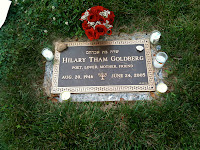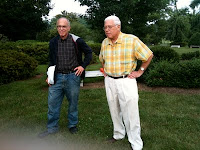Engaging in collaborative projects is not easy or necessarily fun.
It is a serious matter that not only puts on trial one’s ego, but also tests the very essence of who one is as an artist. Since her
first opera project that came to successful conclusion in New York City, the Steiny Road Poet has learned a tremendous amount about risking her time and talents with other people. No matter how stressful personal relations can be during a collaborative project, one hopes for the greater good.
--Improv is a fickle process.

If the first attempt to combine poetry, music, and dance creates something magical, don’t expect that to be repeated unless you hire a seasoned theater director and that director gets a new set of professional performers. Short of capturing what came to be “Jane Bowles at Camp” on video footage, what the Steiny Road Poet remembers about the first session on her piece was its simplicity. There was the poet delivering her lines, the large red and white umbrella, the dancer who engaged with the umbrella, and the two itinerant poets who traveled in and around the dancer. The itinerant poets, one dressed in an eye-catching costume with turban and shaw, made the shaw a river behind the dancer who was hidden from view by the oversized umbrella. What was seen of the dancer was minimal, though full of little sparks of mischief. The music included the sonorous flow of the cello, the insistent voice of the flute, an underlying strumming of guitar, and an occasional accent of drums.
The second attempt of what became “Jane Bowles at Camp” felt lifeless since the itinerant poets never came on stage that night and so the third attempt, where the piece was actually named, drove the Poet to change what she read. She added a lot more text, which caused one of the collaborating poets to get upset with the new information. It was a good discussion, but by opening night, the producing poet Anne Becker asked the Steiny Road Poet to go back to the original text. That was gladly done.
The Steiny Road Poet is eager to see what was captured on film by the Takoma Park cable TV technicians, but she feels certain that the stage was overly busy with too many people on stage. Maybe this is something that could not be helped. The Steiny Road Poet has to be pleased that so many of the performers wanted to play in this piece.
--Pay attention & find out who your collaborators are.
It’s easy to get caught up in the process of creating a new piece and working with artists from various disciplines and then suddenly realize, you don’t know anything about your collaboration partners. The more you know about your partners, the easier it is to understand where they are coming from and how to negotiate what you feel is needed to make a piece a successful collaboration.
Another thing that happened to the Steiny Road Poet was she recognized that she had seen and talked with one of the musicians who perform in a new music concert that the Poet had reviewed. Also she had an impromptu collaboration with a dancer at a garden party back in the 1980s that was much along the lines of Anne Becker’s project. The odd thing was the Steiny Road Poet did not immediately recognize this person until the dancer struck a certain pose, at which point the Poet realized she a copy of a photo taken of this dancer at that garden party at the finish of that long-ago collaborative dance.
Maybe what needed to happen with the Becker Project was that a blog should have been created to provide biographical details of the performers and to post what happened at each session. The Steiny Road Poet, like other participants, did not attend every session and therefore, lost opportunity to hear all the introductions and get to know everyone.
--Go by the book. Don’t assume that collaboration partners will agree with you.
At the eleventh hour, the Steiny Road Poet made a short video (hours of work) based on early development of a piece that changed dramatically by the time it reached the public stage on June 17. The Steiny Road Poet thought the piece was fascinating and would show a potential audience member how our process worked. The poet of said piece was surprised about the early footage, but one of the dancers was upset that the Steiny Road Poet had moved forward without getting everyone’s permission to air the video on YouTube. The Steiny Road Poet, as asked, removed the video from public view.
--Do what it takes to support the leader of the project.
The process of collaboration is hard and made more so when the workshop period is at night when people are tired. Therefore, when thorny things happen, like someone losing patience with the process, misunderstanding what someone has said, unable to express him/herself clearly, it is vitally important that things do not get out of control. It is probably a good idea to ensure that every collaboration project includes some seasoned veterans who are levelheaded. What everyone should want is to see the project come to successful fruition. This cannot happen if any of the partners, including the leader, are not allowed to vent in a controlled situation. By “controlled situation,” the Steiny Road Poet means that no one should be allowed to leave the workshop space mad. The Steiny Road Poet knows that an angry exit causes many partners to lose face.
Finally, everyone should be asked to sign an agreement that lays out the scope of the project and the ground rules. The agreement should also contain a release that allows for photographs and videos to be taken which would promote the final performance. Any such products should be sent to the project leader for review and approval. This would also include images being use on blogs. Those who aren’t comfortable with this advance permission probably should not participate in the project.
Other Remarks
The Steiny Road Poet enjoyed the process and experienced wonder or amazement more than fun. She finds these kind of projects educational but not necessarily recreational. Would she do it again? Probably, yes. She has the utmost respect for Anne Becker and thinks she is an outstanding creative leader.
Photo by: Joshua Prentice





































